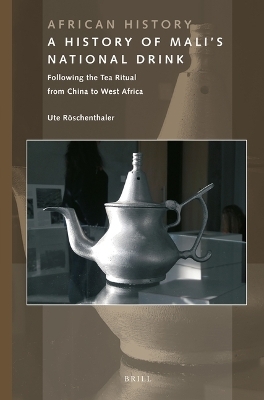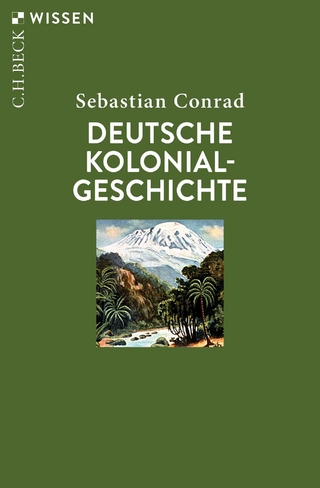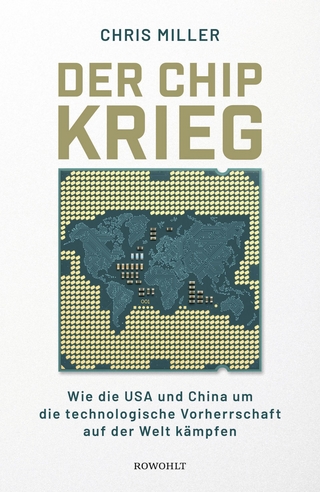
A History of Mali’s National Drink
Brill (Verlag)
978-90-04-52466-8 (ISBN)
Green tea, imported from China, occupies an important place in the daily lives of Malians. They spend so much time preparing and consuming the sugared beverage that it became the country’s national drink. To find out how Malians came to practice the tea ritual, this study follows the beverage from China to Mali on its historical trade routes halfway around the globe. It examines the circumstances of its introduction, the course of the tea ritual, the equipment to prepare and consume it, and the meanings that it assumed in the various places on its travel across geographical regions, political economies, cultural contexts, and religious affiliations.
Ute Röschenthaler, Ph.D. (1991), Johannes Gutenberg University, Mainz, is extracurricular professor of anthropology and PI in the project “Cultural Entrepreneurship and Digital Transformation in Africa and Asia”. She is the author of African Agency in China’s Tea Trade: Commercial Networks, Brand Creation and Intellectual Property (Brill 2022).
Preface and Acknowledgements
List of Figures
Introduction: Following the Drink
1 Tea as a Subject of Study
2 Central Issues of This Study
2.1 The Choice of the Beverage and Its Social Meanings
2.2 Mobility and Unity
2.3 The Teascape and the Diffusion of Tea in the Context of Trade
3 Research Methodology
4 Organisation of the Book
1 The History of Tea in Mali
1 The History of Bamako’s Tea Market
2 Tea in Timbuktu in the Early Nineteenth Century
3 The Availability of Tea during French Colonial Time (1883–1960)
4 The Postcolonial Period (1960–1991) and Mali’s Tea Plantation
4.1 The Creation of the State-owned Tea Plantation in Farako
4.2 The SOMIEX (1962–1991) and the Government’s Attempts to Control Imports
4.3 Mali’s Tea Plantation Created an Awareness of Tea
5 The Tea Market after the 1991 Reforms
5.1 The Distribution Network of Tea Importers
5.2 Types of Green Tea on the Malian Market
6 Conclusion: Mali, a Centre of Tea Distribution
2 The Journey of Tea from China via Britain and Morocco to the Western Sahel
1 China’s Tea Production for Export
2 When Tea Met Coffee: Historical Coincidences
2.1 The Coffee Frontier
2.2 First Reports about Tea, the Portuguese Traders in Macau and Competition with Dutch and British Merchants
2.3 The Introduction of Green Tea to the English Court by Catherine of Braganza
3 The Rise of Tea in Morocco
3.1 The Arrival of Tea in the Sultan’s Palace
3.2 The Creation of Essaouira and the Sultan’s Traders
3.3 The Afriat Family: Tujar as-Sultan and Leading Tea Traders
4 The Caravan Trade from Wad Noun to Timbuktu
4.1 The Trade Route across the Sahara from Wad Noun to Timbuktu
4.2 Trade Networks across the Sahara and the Financing of Caravans
5 Tea in Morocco and the Sahara in the Nineteenth and Twentieth Centuries
5.1 The Dissemination of Tea in Moroccan Society
5.2 British Competition in Tea Cultivation and Failed Attempts at Selling Black Tea in Morocco
5.3 Tea as a Medium of Political Persuasion, European Conquest and Colonial Intervention in Morocco and the Sahara
5.4 Tea during French Administration in Morocco
5.5 Tea in Northern Morocco in the Twentieth Century: Direct Imports from China
6 Conclusion: The Influence of Trade Routes and Politics on the Taste for Tea
3 The Tea Ritual, Its Spatiality and Complexity
1 Drinking Tea in China, Britain, and Morocco
1.1 Chinese Tea Drinking Rituals
1.2 Tea Rituals in Britain
1.3 The Moroccan Tea Ritual
2 The Tea Ritual and Its Associated Equipment in the Sahara and in Mali
2.1 The Tea Ritual of Nineteenth-Century Saharan Traders, Chiefs, and Nobles
2.2 Tea for the Caravan
2.3 The Tea Ritual in Nineteenth-Century Northern Mali
2.4 Functionaries and Elders Drinking Tea in Mali ( from the 1960s Onwards)
2.5 The Grins: Groups of Friends Taking Tea ( from the Mid-1980s Onwards)
3 The Ingredients of the Beverage
3.1 The Types of Tea Leaves Available
3.2 Water
3.3 Sugar
3.4 Milk
3.5 Herbs, Essential Oils, and Spices
3.6 Tea and Snacks
4 Spatiality, Enchantment, and Temporality of Tea Consumption
4.1 The Topography of Tea Consumption
4.2 The Tea Ritual’s Enchantment
4.3 The Preparation, the Froth, and the Sensuality of Tea
4.4 The Duration of the Tea Ritual
4.5 The Master of Ceremonies and Social Hierarchy
5 Conclusion: Continuity, Complexity and Change in the Tea Ritual
4 Malian Tea Equipment: History and Provenance
1 The Tea Equipment
1.1 The Teapots L
1.2 Bowls, Cups and Glasses
1.3 The Rise of the Tea Glasses
1.4 Metal Crafts
1.5 Metal Trays and Tea Sets
1.6 Stoves, Water Heaters and Samovars
2 Tea Sets from England and China: Models for the Moroccan (and Malian) Tea Equipment?
2.1 The British and Chinese Precursors of Moroccan Tea Sets
3 Genealogies and the Socio-Economic Importance of the Tea Equipment
3.1 Genealogies and Modifications of the Tea Equipment
3.2 Industries Emerging for the Production of Tea Equipment
3.3 The Tea Equipment as a Unit and Signifier of Social Status
4 Intersections of Tea Knowledge Transfer, Equipment, and Vocabulary
4.1 Pathways of Knowledge Transfer
4.2 The Dissemination of Tea Drinking in Mali
4.3 Knowledge Transfer and the Vocabulary of Tea Things
5 Conclusion: The Dissemination of Tea Culture
5 Ambivalent Meanings Attributed to Tea
1 From Medicine to a Luxury and a Drink for the People
2 Songs and Poems Mirroring Social Concerns and Tea’s Ambivalent Meanings
2.1 Poems and Proverbs Inspired by the Tea Equipment
2.2 Tea, Sex, and Women
3 Tea as a Mirror of the Social Condition: Politics and Religion, Critics and Advocates
3.1 Tea as a Mirror of the Social Condition in Mali
3.2 The Compatibility of Green Tea Consumption with Work
3.3 Tea, Grins, and Youth Unemployment
3.4 The Politicisation of Tea in Mali
3.5 Tea as Part of the Gift Economy
4 The Social Impact of Tea, Its National Importance, and the Items It Replaced
4.1 Tea as a Luxury or a Staple and the Nutrition Replacement Argument
4.2 Tea as a National Drink and Symbol of Identity
5 Conclusion: Tea as a National Symbol despite Criticism and Foreign Origin
Conclusion: Tea, Mali’s National Drink
1 Diffusion, Globalisation, Trickle Down and Moving Up or On?
2 Complexity and Unity
3 Cultural Practices, ‘Drinkways’ and the Teascape
4 Complex Meanings of Green Tea and Tea Knowledge Transfer
5 Green Tea Remains the Dominant Drink Despite the Market Economy and Advertising
References
Index 258
| Erscheinungsdatum | 05.09.2022 |
|---|---|
| Reihe/Serie | African History ; 11 |
| Verlagsort | Leiden |
| Sprache | englisch |
| Maße | 155 x 235 mm |
| Gewicht | 482 g |
| Themenwelt | Geisteswissenschaften ► Geschichte ► Regional- / Ländergeschichte |
| Geschichte ► Teilgebiete der Geschichte ► Wirtschaftsgeschichte | |
| Sozialwissenschaften | |
| ISBN-10 | 90-04-52466-5 / 9004524665 |
| ISBN-13 | 978-90-04-52466-8 / 9789004524668 |
| Zustand | Neuware |
| Haben Sie eine Frage zum Produkt? |
aus dem Bereich


